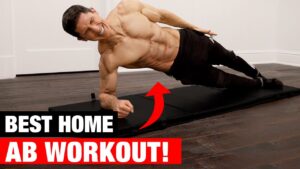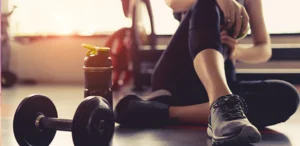Exercise can help you shed unwanted pounds, feel more energetic, and cope better with life’s ups and downs. But this doesn’t have to be in the form of strenuous gym sessions or costly fitness classes; even taking part in moderate activity like walking can have benefits!
Here are 10 daily exercises you can do at home or while traveling to stay fit without joining a gym.
1. Push-ups
Push-ups are an easy, equipment-free exercise designed to strengthen shoulders, chest and upper arms. Push-ups have become a staple of military training programs as well as fitness regimes worldwide.
ACE recommends starting slowly by doing just a few push-ups each day and gradually increasing them as strength improves – taking care not to rush too many reps too quickly, which could result in shoulder injuries.
Beginners may begin with wall push-ups, in which hands are placed slightly wider than shoulder width apart on a wall; difficulty can be increased by moving farther from it.
2. Squats
Squats are an engaging bodyweight exercise that engages multiple muscle groups simultaneously. Squats strengthen your quads, hamstrings and glute muscles while also helping you burn calories more efficiently.
To perform a basic squat, start by standing with feet slightly wider than hip width apart and toes pointed forward. Slowly lower your hips and knees until they form an angle of 90 degrees, before raising back up again.
Add an extra challenge by holding weights like a kettlebell or dumbbell in front of you, or try plyometric variations like squat jumps to increase heart rate and burn more calories.
3. Lunges
Lunges are an ideal way to build lower body strength while also improving balance, flexibility, and functional movement. As an additional benefit, they’re low-impact exercises that can be done anywhere without equipment requirements – perfect for busy lifestyles!
To perform a lunge, start by standing with feet hip-width apart and take one large step forward, lowering until your front knee reaches about 90 degrees angle. Repeat on opposite leg or alternate between them.
Hold weights for an increased challenge as this will help build muscular endurance and strengthen over time.
4. Sit-ups
Sit-ups have long been considered one of the go-to abdominal exercises, yet if done incorrectly they can put strain on both hips and back. Furthermore, they’re not as beneficial to core strength or stability than other exercises.
To perform a sit-up, lie on the floor with bent knees and flat feet. Exhaling, raise your torso toward your knees before slowly lowering back down with each exhale. This movement works your abs and obliques but not as effectively as crunches which specifically target rectus abdominis muscles; additionally it requires lumbar flexion that may result in spine injuries if performed excessively.
5. Yoga
Yoga offers an effective full-body workout, offering cardio, flexibility, muscle-toning and strength training – while at the same time improving balance and coordination.
Studies have demonstrated the health benefits of yoga to include improved cardiovascular-metabolic health, decreasing your risk for heart disease. Yoga also can increase thoracic spine active range of motion which is important for people suffering chest or upper back pain.
Be sure to consult with your physician prior to beginning any new exercise program, particularly if you have preexisting conditions such as back problems.
6. Stretching
Stretching can increase flexibility, enhance balance and posture, and help prevent injuries. When stretching, move slowly into each position until tension but no pain arises – no bouncing! Or overusing of muscles as this could cause injury.
Dynamic stretching exercises such as controlled leg and arm swings or torso twists provide effective warm-ups before more strenuous exercise. While static stretching involves holding positions for twenty seconds or more, it should only be used after exercising to relax muscles and increase flexibility.
7. Walking
Walking is an underrated form of exercise that can be completed either at home or while out and about. Try taking the stairs instead of an elevator, parking further away from your destination to increase step count, or parking further back so as to get more steps into your day.
Buy or download a fitness app to keep track of your daily goals and motivate you to hit the pavement. For optimal results, stretch at the end of every walk — particularly your calves, back, and shoulders to help prevent injury. Brisk walking can be considered light, moderate, or intense exercise depending on its pace and incline.
8. Swimming
Swimming is an effective way to both burn calories and work all parts of the body simultaneously, while remaining low-impact enough not to aggravate joints.
Based on your body weight, swimming laps can burn up to 423 calories an hour! The resistance of water helps strengthen and tone muscles while different strokes target different muscle groups – for instance freestyle, breaststroke and butterfly work your arms while flutter kicks strengthen endurance in legs.
Experts advise adults to engage in 150 minutes of moderate aerobic and muscle-strengthening activities each week, with swimming or other aquatic exercises such as water walking or aqua aerobics helping meet this recommendation without needing to visit a gym.
9. Rowing
Rowing offers an effective combination of cardio and strength training that works all major muscle groups in your legs, back, chest, arms and core – as well as improving posture to reduce risk for lower back pain.
Recent research indicates that using a rowing machine for six weeks positively affects body composition, physical fitness and strength. Furthermore, rowing provides low-impact exercise without straining joints; furthermore it has the ability to help manage blood sugar levels and lower cardiovascular risk factors, making it an excellent workout choice for people living with diabetes or heart disease.
10. Meditation
Meditation can be practiced at home without needing special equipment. Simply follow the guided instructions of any available audio recordings for instructions to retrain your mind, optimize distraction filters, and strengthen focus.
Participating in recreational sports engages multiple muscle groups and strengthens strength, grip strength, balance and coordination while building social inclusion and confidence.
Walking your pet for 30 minutes twice each day burns calories and strengthens different muscle groups, while making housework exercise time. Engaging in cardio or resistance training at home with games such as ping pong or shooting hoops provides additional cardio workout.




